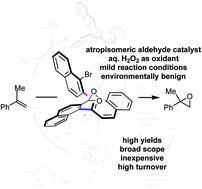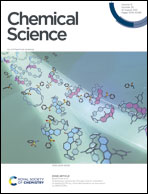Aldehyde-catalyzed epoxidation of unactivated alkenes with aqueous hydrogen peroxide†
Abstract
The organocatalytic epoxidation of unactivated alkenes using aqueous hydrogen peroxide provides various indispensable products and intermediates in a sustainable manner. While formyl functionalities typically undergo irreversible oxidations when activating an oxidant, an atropisomeric two-axis aldehyde capable of catalytic turnover was identified for high-yielding epoxidations of cyclic and acyclic alkenes. The relative configuration of the stereogenic axes of the catalyst and the resulting proximity of the aldehyde and backbone residues resulted in high catalytic efficiencies. Mechanistic studies support a non-radical alkene oxidation by an aldehyde-derived dioxirane intermediate generated from hydrogen peroxide through the Payne and Criegee intermediates.

- This article is part of the themed collection: 2021 Chemical Science HOT Article Collection


 Please wait while we load your content...
Please wait while we load your content...